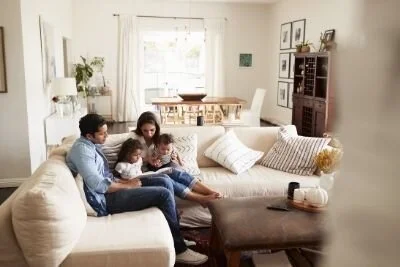The Difference Between a Living Room and a Family Room
As our lifestyles evolve, our homes evolve to meet new needs. Basements are finished now, bathrooms are larger, and ceilings are higher. One side effect: The lines are getting blurred between home spaces, and it’s getting harder to tell the difference between a living room and a family room. Open floor plans and less formal leisure time may cause you to question the purpose of each room. But there’s a place for both in your home, particularly if you love entertaining.
The Family Room
After World War II, the family room was invented for families to reunite and spend time together. It grew larger to accommodate televisions as they became mainstream. Now, they are less formal gathering spaces where family members can put their feet up on the couch or lounge on the floor with cushions. Cozier than living rooms, family rooms are more kid-friendly. It’s home to so many activities—reading, gaming, watching movies, and even exercising—that abundant storage is key.
Location
It’s ideally located next to the kitchen, so families can grab snacks or even eat in front of the TV. Often it has a door with access to the backyard, deck, or garden. Family rooms are often near the back of the house, intended mostly for private use, not guests.
Also Known As
Den
Media room
Rec room
Game room
Distinctive Furniture
Entertainment center
Sectionals and recliners
Large, functional coffee table
Ottomans with storage
Accents
Durable indoor/outdoor fabrics
Throw blankets
Cushions
Family photos
The Living Room
Victorian parlors evolved into living rooms, which are less fussy now, and more comfortable for guests. While the focus of family rooms is often directed at various screens, living rooms are still about entertainment, focusing more on guests and conversation. It’s a showcase—and safe space—for more valuable possessions.
Location
The living room is nearer to the entrance of the house, making it convenient for visitors. It’s usually connected to the dining room, so parties can graduate from cocktails to dinner.
Also Known As
Cocktail room
Front room
Drawing room
Sitting room
Distinctive Furniture
Loveseats and accent chairs
Antiques
Piano
Display cabinet
Accents
Expensive art
Heirlooms
Ornate rugs
Coffee table books
Can they be combined?
Sure! In many new constructions, the living and family rooms are consolidated into one large “great” room, with high ceilings, large windows looking onto the lawn, and easy access to the kitchen. Combining the rooms isn’t without its challenges—it needs to be casual enough for the clutter of frequent family use but presentable enough for guests.
Historically, the purposes for each area made the differences between living and family rooms much more distinct. You can decide to use one room for guests and the other for family, combine them, or convert them. What’s important is that these spaces meaningfully contribute to the way you want to live.


